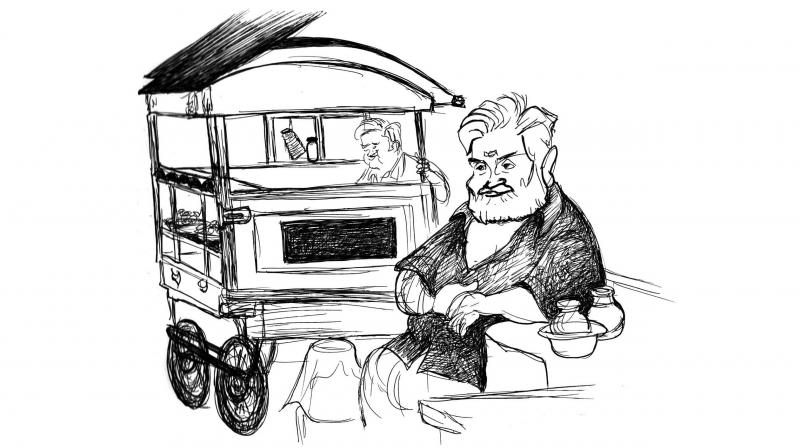The TamBrams: From Palghat to the world
Palghat Iyers have always had an abiding interest in music in its entirety and Das dwells in considerable depth into their contribution.
In the 1977 avant-garde Tamil film, Agrahathil Kazhuthai (A donkey in the Agraharam), Kerala-born director John Abraham uses beats of the idakka, a typical Malayali percussion instrument, to provide the background score for the title rollout. Beats of the idakka as the background for a Tamil movie are also emblematic of the Tamil Brahmin in Kerala — neither here nor there, or, everywhere — depending on how you look at their social stratification.
Nomadic as he was, it was no wonder John Abraham took a fancy for a story around the agraharam — rows of linear Tamil Brahmin houses built “cheek-by-jowl with another and with only a common wall separating them”, as journalist M.K. Das writes evocatively in his new book, Saga of Kalpathy.
These old-world settlements in Kerala have long aroused interest in the story of the migration of a community which has a shown a strong instinct for holding on to its traditions, even as it has adopted the most modern of developments.
My lasting imagery of this trait was the sight, recently, in Kerala’s capital Thiruvananthapuram, of a Tamil brahmin priest conducting rites for an Upanayanam (the initiation into sacred thread-hood) by using wi-fi connectivity on an Apple gadget to get the mantra-chanting right!
Nothing much substantial has been written so far about the journeys in Kerala of this ethnic group and Das’ well-sourced work is unique, in that respect. Though Tamil Brahmins are spread all over Kerala, including in the most unlikely of places like Pala and Munnar, in the Christian stronghold districts of Kottayam and Idukki respectively, Palghat Iyers have been icons undoubtedly of the caste.
 Saga of Kalpathy: The story of Palghat Iyers by M.K. Das sketches by E.P. Unny Darpan, Rs 599.
Saga of Kalpathy: The story of Palghat Iyers by M.K. Das sketches by E.P. Unny Darpan, Rs 599.
“Naan Paalakkad Akkum” (literally meaning “I am Palakkad”) is the conversational gambit among Iyers of Palghat, when they meet, whether in Adelaide or Addis Ababa and quite likely that this line finds a resonance in most parts of the world now, for the Iyer from Palghat has been truly peripatetic in his quest for survival.
Das likens them to Jews — abstemious, insular, intelligent and hardworking. Quite empathetically, he traces their story betraying perhaps a touch of fondness for this peaceful, middle-of-the-road cloistered group, which gets by with its premium on education as a tool for advancement.
Piecing together information and material from monographs, Das’ tome is authentic in its content and reflects the tremendous legwork that he and Unny — India’s best contemporary cartoonist — have done for putting together the compilation.
“The houses of the gramams are built contiguous. In straight streets; and they are the neatest and cleanest villages that I have seen in India. The beauty, cleanliness and elegant dress of the girls of the Brahmans add much to the look of their places...” Das quotes from Francis Buchanan’s 19th century work, A journey through the countries of Mysore, Canara and Malabar.
Palghat Iyers have always had an abiding interest in music in its entirety and Das dwells in considerable depth into their contribution.
While the likes of Palghat Mani Iyer and Chembai Vaidyanatha Bhagavathar are well-known, Das brings to focus the legendary Venkichan Swamy of Thiruvilwamala, who systematised and choreographed the present-day Panchavadyam.
While Das writes with the sure touch of a seasoned journalist, avoiding ponderous prose, Unny has drawn sights he saw during their joint travels while preparing for this work. Unny’s sketches are actually a book within a book.
As one leafs through them, his light touches like that of Manjapra agraharam or dense lines like those depicting the chariot at Kalpathy provide vignettes of this saga separately.
Endearing as they are, Unny seems to tell a separate tale, vivid in detail and dramatic in its vista. Quintessentially sensitive, Unny’s sketches will appeal to Tamil brahmins in general, wherever they hail from, for they reflect, I suspect, his deep understanding of their psyche, not the least because of seeing them from close quarters right up to his adulthood in Palghat.
“Cooks, crooks and civil servants,” was how a famous Palghat Iyer himself — the late Chief Election Commissioner, T.N. Seshan — described the composition of his community in a light-hearted self-deprecatory comment.
Members of his community are now spread all over the world and have ensconced themselves in powerful positions in bureaucracy, business and other fields.
Their saga is fascinating and the offering of M.K. Das and E.P. Unny is a definitive contribution to the understanding of sociologists and laymen alike, of their continuing journey.


















